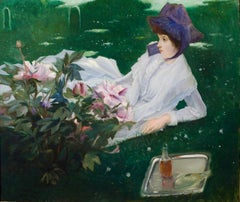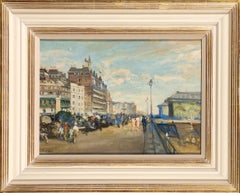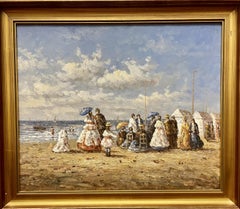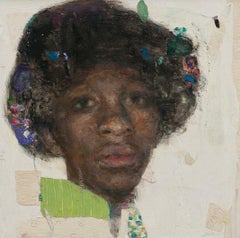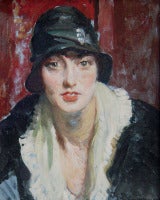Jacques Emile Blanche Figurative Paintings
to
4
1
5
4
1
1
2
2
Overall Height
to
Overall Width
to
3
1
5
2
1
1
1
1
1
1
1
1
4
8
399
222
205
102
5
5
4
4
Artist: Jacques Emile Blanche
Jeune Fille en Blanc - 19th Century Oil Painting Portrait of Young Paris Beauty
By Jacques Emile Blanche
Located in Gerrards Cross, GB
‘Jeune Fille en Blanc’ by Jacques-Émile Blanche (1861-1942).
The painting – which depicts one of the artist’s favourite models Wanda Zielinska – is signed and dated 1896. It is lis...
Category
Late 19th Century Impressionist Jacques Emile Blanche Figurative Paintings
Materials
Oil
Bathers on the Beach - Post Impressionist Landscape by Jacques-Emile Blanche
By Jacques Emile Blanche
Located in Marlow, Buckinghamshire
Signed post impressionist oil on canvas landscape by French painter Jacques-Emile Blanche. The work depicts crowds of people enjoying a day at Brighton beach on the south coast of England. Bathers are dotted across the sandy beach with the pier on the right hand of the scene and the Grand Hotel behind.
Signature:
Signed lower right
Dimensions:
Framed: 29.5"x47.5"
Unframed: 22.5"x39.5"
Provenance:
Private collection - Italy
This work will be included in the catalogue raisonne of the work of Jacques Emile Blanche currently under preparation by Dr Jane Roberts & Muriel Molines
Blanche received training from Gervex and Fernand Humbert. His grandfather was Émile Antoine Blanche, the psychiatrist who treated the poet Gérard de Nerval on several occasions. He was awarded a gold medal at the Exposition Universelle in Paris in 1900, and was a Commander of the Légion d'Honneur. He was well known in French and British artistic circles, and married the daughter of John Lemoine, the leader of the Diary of the Proceedings ( Journal des Débats), and author of the Life of Brummel. He exhibited his works in London and Paris.
Blanche had a wide circle of acquaintances, and the list of portraits which he executed is indicative of the diversity of those who used to meet at his home: Henri Bergson; Stéphane Mallarmé; Henry Bernstein (1902); André Gide (1912); Anna de Noailles (1912); Jean Cocteau (1912); Igor Stravinsky (1915); Francis Jammes (1917); Paul Claudel (1919); Jean Giraudoux; Paul Valéry; Marcel Proust; Max Jacob (1921); Maeterlinck (1931); Debussy; Antoine Bourdelle; George Moore; André Maurois; François Mauriac; Maréchal Foch and the Princess de Broglie.
He also wrote novels, which were more or less autobiographical, and essays, such as From David to Degas; Dates; From Gauguin to the Negro Review; Journals of an Artist ( De David à Degas; Dates; De Gauguin à la Revue nègre; Cahiers d'un artiste) in six volumes, and Manet. During meetings at his studio, he used to collect any snippets that would flesh out the essays he wrote, which alternated between being sharp and emotive. He gave them in series to the magazine Comoedia, under the title of Studio Talk. It was said that he aroused tremendous debate, notably with André Lhote, a painter younger than himself, who also doubled as a critic. The latter initially attempted to define the main characteristics of the art of the 'rebellious and charming Jacques Émile Blanche,' but subsequently treated him less generously, referring to a painter 'attached to the notion of 'high-and-mighty' genre painting.' He added that this sort of painting was marvellously illustrated by Manet.
The quality of his flat surfaces, the precious greys and silvery light effects cause Jacques Émile Blanche to be compared more with Manet, whom he admired, than with the Impressionists, with whom he was compared in terms of his early works. Nevertheless, his outdoor backgrounds with traces of sometimes vivid colours have something in common with them.
In the aftermath of World War I, he spent a long time on an enormous composition entitled Tribute to those who Died in the War. It was executed in a style which was totally different to his work as a whole. He offered this work to the church in Offranville near Dieppe. He also donated around 100 of his works to the Musée des Beaux-Arts in Rouen.
He regularly exhibited in Paris, at the Salon of the Société Nationale des Beaux-Arts (also known as the Salon de Mars) from the time it was founded in 1890. At the time of the initial exhibitions held by the Société Nationale des Beaux-Arts, he rapidly gained fame by exhibiting such portraits as Paul Adam and Charles Cottet...
Category
Mid-20th Century Post-Impressionist Jacques Emile Blanche Figurative Paintings
Materials
Canvas, Oil
At the Races - Post Impressionist Horses & Figures Oil by Jacques-Emile Blanche
By Jacques Emile Blanche
Located in Marlow, Buckinghamshire
Signed post impressionist horses and figures in landscape oil on canvas by French painter Jacques-Emile Blanche. The work depicts crowds of people enjoying a day at the races and watching a steeplechase horse race as the horses and their jockey's jump a fence.
Signature:
Signed lower right
Dimensions:
Framed: 28"x36"
Unframed: 21"x29"
Provenance:
Private French collection.
This work has been authenticated by Dr Jane Roberts and a certificate of authenticity will accompany the painting.
Blanche received training from Gervex and Fernand Humbert. His grandfather was Émile Antoine Blanche, the psychiatrist who treated the poet Gérard de Nerval on several occasions. He was awarded a gold medal at the Exposition Universelle in Paris in 1900, and was a Commander of the Légion d'Honneur. He was well known in French and British artistic circles, and married the daughter of John Lemoine, the leader of the Diary of the Proceedings ( Journal des Débats), and author of the Life of Brummel. He exhibited his works in London and Paris.
Blanche had a wide circle of acquaintances, and the list of portraits which he executed is indicative of the diversity of those who used to meet at his home: Henri Bergson; Stéphane Mallarmé; Henry Bernstein (1902); André Gide (1912); Anna de Noailles (1912); Jean Cocteau (1912); Igor Stravinsky (1915); Francis Jammes (1917); Paul Claudel (1919); Jean Giraudoux; Paul Valéry; Marcel Proust; Max Jacob (1921); Maeterlinck (1931); Debussy; Antoine Bourdelle; George Moore; André Maurois; François Mauriac; Maréchal Foch and the Princess de Broglie.
He also wrote novels, which were more or less autobiographical, and essays, such as From David to Degas; Dates; From Gauguin to the Negro Review; Journals of an Artist ( De David à Degas; Dates; De Gauguin à la Revue nègre; Cahiers d'un artiste) in six volumes, and Manet. During meetings at his studio, he used to collect any snippets that would flesh out the essays he wrote, which alternated between being sharp and emotive. He gave them in series to the magazine Comoedia, under the title of Studio Talk. It was said that he aroused tremendous debate, notably with André Lhote, a painter younger than himself, who also doubled as a critic. The latter initially attempted to define the main characteristics of the art of the 'rebellious and charming Jacques Émile Blanche,' but subsequently treated him less generously, referring to a painter 'attached to the notion of 'high-and-mighty' genre painting.' He added that this sort of painting was marvellously illustrated by Manet.
The quality of his flat surfaces, the precious greys and silvery light effects cause Jacques Émile Blanche to be compared more with Manet, whom he admired, than with the Impressionists, with whom he was compared in terms of his early works. Nevertheless, his outdoor backgrounds with traces of sometimes vivid colours have something in common with them.
In the aftermath of World War I, he spent a long time on an enormous composition entitled Tribute to those who Died in the War. It was executed in a style which was totally different to his work as a whole. He offered this work to the church in Offranville near Dieppe. He also donated around 100 of his works to the Musée des Beaux-Arts in Rouen.
He regularly exhibited in Paris, at the Salon of the Société Nationale des Beaux-Arts (also known as the Salon de Mars) from the time it was founded in 1890. At the time of the initial exhibitions held by the Société Nationale des Beaux-Arts, he rapidly gained fame by exhibiting such portraits as Paul Adam and Charles Cottet. He sometimes grouped together several members of the same family in one painting: The Painter Thaulow and His Family in 1895, The Vielé-Griffin Family, and numerous refined portraits of key figures in France and England.
Apart from this Salon, for which he was one of the first driving forces and founder members, he was later to put in a great deal of effort on the occasion of the Salon des Tuileries between 1933 and 1939, even though he was by then in his seventies and already famous.
He exhibited genre scenes, scenes of fashionable places - like Brighton or Dieppe - and racecourse scenes at the Salon des Tuileries in 1933. These included Family of Pedlars in London; Portrait of the Female Novelist Sylvia Thompson; Racecourses in Ireland; Arrival of the Herring in Dieppe; White Masts; Brighton; in 1934: Portrait of James Joyce; Grand National Steeplechase; Spring Races in England (sketch); Dieppe Beach; Outer Harbour of Dieppe in Autumn; in 1935: Rugby; Walter Richard Sickert; Dieppe; Tea Party at the Madeleine; in 1939: Love Thy Neighbour. Many exhibitions have been dedicated to him since his death, including one at the Musée des Beaux-Arts in Rouen in 1997, and one at the Galerie Philippe Heim in Paris in 1999.
Museum and Gallery Holdings:
Brussels: Portrait of the French Painter Charles Cottet
Dieppe: Sleeping Child; Fish Week
Dijon: General Mangin; The Sailing Ship
London (Tate Collection): Francis Poictevin (1887, oil on canvas, portrait); Charles Conder (1904, oil on canvas, portrait); Ludgate Circus: Entrance to the City (November, Midday) (c. 1910, oil/panel); August Morning, Dieppe Beach (c. 1934, oil on canvas); other paintings
Lyons: Portrait of Debussy
Mulhouse: Begonias
Paris (Louvre): The Painter Thaulow and his Family (1895)
Paris (MAM): The Pink Room; The Port at Le Havre; Flowers in a Vase; Still-life; Portrait of the Artist's Mother (June 1895); Portrait of Igor Stravinsky
Paris (Mus. Carnavalet): Portrait of Jean Cocteau...
Category
Mid-20th Century Post-Impressionist Jacques Emile Blanche Figurative Paintings
Materials
Oil, Canvas
Henriette Chabot with Peonies
By Jacques Emile Blanche
Located in Washington, DC
This painting was owned by Comte Robert de Montesquiou (1855–1921), Paris
Literature:
Jane Roberts, Jacques-Émile Blanche (2012), pg. 47 (color illus.), p. 191.
Included as no. R...
Category
Early 20th Century Post-Impressionist Jacques Emile Blanche Figurative Paintings
Materials
Oil, Canvas
King's Road, Brighton
By Jacques Emile Blanche
Located in Belgravia, London, London
Oil on canvas
Canvas size: 13 x 18.25 inches
Framed size: 19.5 x 24.5 inches
Signed lower left
Category
20th Century Jacques Emile Blanche Figurative Paintings
Materials
Canvas, Oil
Related Items
Edwardian Beach Scene, British 20th century oil on canvas
Located in Hillsborough, NC
Richly-colored and vibrant Edwardian Beach Scene, British oil painting on canvas in impressionist style, presented in contemporary gold frame. The oil paint is raised and textured, lifting the beach sands, sea, sky and dresses from the canvas. Gathering in Edwardian period costuming looks out over the sands to the sea and clouds, with distant sailboats and children playing in the waves.
This is a delightful contemporary painting, unsigned, but original oil dating to the 20th century. Framers tags verso from Oxford and Glasgow.
In very good condition, with a few minor chips on the gold frame, but otherwise the painting is bright and beautiful.
Provenance to gallery in the United Kingdom, imported by Saltire Gallerie...
Category
20th Century Impressionist Jacques Emile Blanche Figurative Paintings
Materials
Oil, Canvas
"Silent Street" Oil Painting
By Ron Hicks
Located in Denver, CO
Ron Hick's (US based) "Axiomatic Appeal" is an original, handmade oil painting that depicts an impasto rendering of a male figure with dark hair and an abstracted background.
Ron Hi...
Category
2010s Impressionist Jacques Emile Blanche Figurative Paintings
Materials
Oil, Panel
Small Neapolitan fishermen. XIX century. With Gulf of Naples and Vesuvius
Located in Firenze, IT
Small Neapolitan fishermen with girl.
XIX century.
Foreign artist active in Italy.
Painting representing two children against the background of the Gulf of Naples with the volcano...
Category
19th Century Romantic Jacques Emile Blanche Figurative Paintings
Materials
Oil, Canvas
Free Shipping
H 25.6 in W 22.05 in D 2.37 in
plowing with oxen oil on board painting Spain
By Juan Soler
Located in Barcelona, Barcelona
Oil measures 30x30 cm.
Frame measures 52x52 cm.
He was born in 1951. Under the direction of the teacher Pedro Bermejo, he began his artistic career, quickly standing out and observing in his works an unusual mastery of drawing.
A highly mature painter who has known how to stop time in all his works. His themes are preferably costumbrist, although in his work it is usual to see 18th century themes, with horse carriages, hats, umbrellas and still lifes.
Observing his work reminds us, due to the theme, of Maestro Palmero...
Category
21st Century and Contemporary Post-Impressionist Jacques Emile Blanche Figurative Paintings
Materials
Oil, Board
Printemps
By Charles Levier
Located in Costa Mesa, CA
A beautiful woman sits at an open window, gazing down at a small bird who has landed nearby in this serene portrait by Charles Levier. Warm orange tones are played off their complements in shades of blue, the artist utilizing several different layers of oils to create a subtle and relaxed view of a spring day near the sea. Beyond the window a small chapel sits on a peninsula, surrounded tranquil blue waters.
This work, like many of Levier's, belongs to the French figurative movement of the Glorious Thirty (Les Trente Glorieuses) - the golden period of thirty years after WWII which were a time of great hope and prosperity in France. Inspired by Hollywood cinema, Charles Levier sought harmony in composition and purity of color and form. His said that his creations represented "a light and delicate world, of dark and subtle shades and colors."
Levier worked in a somewhat abstracted, cubist style. Additionally he often employed the French technique of "cloisonnism" (after the French for "partition"), a style of post-Impressionist painting with bold and flat forms separated by dark contours, also seen in this work. The term was coined by critic Edouard Dujardin on the occasion of the Salon des Indépendants, in March 1888 and was commonly used by artists like Émile Bernard, Louis Anquetin, Paul...
Category
Mid-20th Century Post-Impressionist Jacques Emile Blanche Figurative Paintings
Materials
Canvas, Oil
The Circus Horses Large French Post Impressionist Oil Circus Ring Interior Scene
Located in Cirencester, Gloucestershire
The Circus
by Josine Vignon (French 1922-2022)
signed
oil painting on canvas, unframed
canvas: 32 x 24 inches
Very good condition
Provenance: from th...
Category
Mid-20th Century Post-Impressionist Jacques Emile Blanche Figurative Paintings
Materials
Oil, Canvas
Henri-André Martin Road in Eygalieres, Alpilles, Provence, Oil on Canvas, 1999
By Henri-André Martin
Located in Saint Amans des cots, FR
Oil on canvas by Henri-André Martin (1918-2004), France, 1999. Road in Eygalieres, Alpilles, Provence. With frame: 52x67 cm - 20.5x26.4 inches. Without frame: 46x61cm - 18.1x24 inches. Format 12P. Signed and dated lower left "Henri-André Martin 99" (see photo). Located on the back (see photo). Can be matched to make a pair with another painting by Henri-André Martin that we offer on 1stdibs whose title is "Henri-André Martin Road in the Alpilles, Provence, Oil on Canvas, 1980s".
Born in Lyon in 1918, the child and the adolescent Henri-André Martin spent his youth in Saint-Étienne, his father, Edme Martin, first installed as a practicing doctor in Lyon, having been appointed doctor of the anti-tuberculosis dispensaries of the Loire.
During his first years of studying medicine in Lyon, he nevertheless enrolled in the Beaux-Arts. Appointed hospital intern upon his return from captivity in 1942, he ended his medical career as director of the otolaryngology university clinic at Édouard-Herriot hospital. But painting was his passion.
Painting was for Henri-André Martin the way of expressing his feelings. By nature very reserved and of an extreme modesty that many took for coldness, it was what allowed him to express his strong artistic sensitivity and, his pictorial periods are as many reflects of his anxieties, of his hopes, of his joys. At every period of his life, wherever he goes and whenever he has a moment, he paints gouaches, often of small size, but sometimes of larger size. He also paints beaches that have been compared to those of Boudin. Their invoice shows, however, that this figure is only appearance and that in fact, these beaches made of water, sky and sand, readily dispense with the motif, the work of the material seeming to have more importance. as the subject. Despite the fact that until the 1970s he painted "on the ground", his canvases remain far removed from the anecdote. Often harsh like the landscapes of Provence, the Parisian walls which express concern, or the railways, the switch tracks which suggest, in ocher and black, all the embarrassment of choice. We find the same nostalgic gravity in the canvases of the carcasses of boats which, as his friend Louis Pons later wrote, "seem to die of immobility" or in the canvases of Venice, or the landscapes of Eygalières.
In the following years, his painting became simpler, more synthetic, such as these landscapes with tortured almond trees, black and gnarled olive trees, plane trees standing out against the ocher sky of the dawn of Provence, in winter. These are also the canvases of Hamburg in the dough becomes heavier, the colors darken, marking all the gravity of the port landscapes. Workshop work gradually takes precedence over motif painting.
The pivotal period coincides with that of his work on the olive tree, during which he leads the realization of the "Trunks", a collection of six lithographic plates, of the book L'olivier comprising many lithographs and serigraphs, but also texts. poetic and numerous paintings. He then became passionate about everything related to the olive tree (literature, painting, traditions, history), but also to the tree itself, its thousand-year-old history, its poetry, its symbols, but also its culture, its size. oil production...
Category
1990s Post-Impressionist Jacques Emile Blanche Figurative Paintings
Materials
Canvas, Oil
H 20.48 in W 26.38 in D 1.19 in
Fishermen on River Idyllic Scandinavian Landscape 19th century Oil Painting
Located in Stockholm, SE
The scene of this landscape unfolds with a tranquil river nestled between rolling hills, its heavily wooded banks casting a serene backdrop. In the center of the composition, two fis...
Category
Late 19th Century Realist Jacques Emile Blanche Figurative Paintings
Materials
Canvas, Wood, Cotton Canvas, Oil
Landscape from the North of Sweden by Swedish Artist Otto Lindberg, 1926
Located in Stockholm, SE
Otto Lindberg was a Swedish artist born in Söderhamn in 1880. Lindberg was known for his landscapes and marine paintings. He studied at the Royal Academy of Fine Arts in Stockholm an...
Category
1920s Post-Impressionist Jacques Emile Blanche Figurative Paintings
Materials
Canvas, Oil
Melancholy in White
By Suchitra Bhosle
Located in Denver, CO
Reclining figure with flowers
Category
2010s American Impressionist Jacques Emile Blanche Figurative Paintings
Materials
Panel, Oil
"Edge of Desire, " Oil Painting
By Suchitra Bhosle
Located in Denver, CO
Suchitra Bhosle's "Edge of Desire" is an original, handmade oil painting that depicts a woman closing her eyes as her long dark hair curtains her face ...
Category
2010s Impressionist Jacques Emile Blanche Figurative Paintings
Materials
Oil, Panel
Cadaques oil on canvas painting Spain spanish seascape
By Rafael Duran Benet
Located in Barcelona, Barcelona
Rafael Duran Benet (1931-2015) - Cadaques - Oil on canvas
Oil measurements 73x92 cm.
Frameless.
Rafael Duran Benet (Terrassa, 1931 - Barcelona, 2015) is a Catalan painter, nephew of...
Category
1990s Post-Impressionist Jacques Emile Blanche Figurative Paintings
Materials
Canvas, Oil
H 28.75 in W 36.23 in
Previously Available Items
Portrait of Mademoiselle Georgette Camille
By Jacques Emile Blanche
Located in Los Angeles, CA
Category
Jacques Emile Blanche Figurative Paintings
Jacques Emile Blanche figurative paintings for sale on 1stDibs.
Find a wide variety of authentic Jacques Emile Blanche figurative paintings available for sale on 1stDibs. You can also browse by medium to find art by Jacques Emile Blanche in canvas, fabric, oil paint and more. Much of the original work by this artist or collective was created during the 20th century and is mostly associated with the Post-Impressionist style. Not every interior allows for large Jacques Emile Blanche figurative paintings, so small editions measuring 25 inches across are available. Customers who are interested in this artist might also find the work of Jean Salabet, Jacques Bouyssou, and Fernand Audet. Jacques Emile Blanche figurative paintings prices can differ depending upon medium, time period and other attributes. On 1stDibs, the price for these items starts at $12,678 and tops out at $49,032, while the average work can sell for $19,048.


